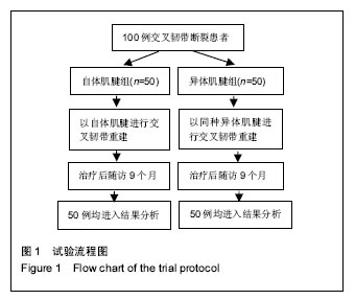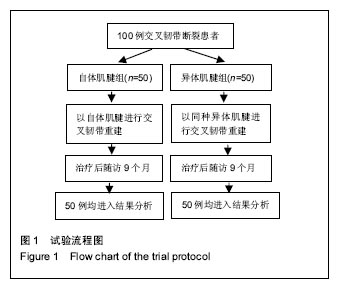Chinese Journal of Tissue Engineering Research ›› 2017, Vol. 21 ›› Issue (34): 5513-5518.doi: 10.3969/j.issn.2095-4344.2017.34.017
Previous Articles Next Articles
Anterior and posterior cruciate ligament reconstruction under arthroscopy: tendon autografts versus allografts
- Department of Orthopedics, Shantou Central Hospital, Shantou 515031, Guangdong Province, China
-
Received:2017-07-03Online:2017-12-08Published:2018-01-04 -
About author:Yang Song-jie, Attending physician, Department of Orthopedics, Shantou Central Hospital, Shantou 515031, Guangdong Province, China -
Supported by:the Scientific Research Plan of Shantou City in 2012, No. E201200538
CLC Number:
Cite this article
Yang Song-jie, Zhang Qing-xu, Chen Xu-biao, Lin Xiao-xu, Qiu Xue-li.
share this article
| [1]Panigrahi R,KumariMahapatra A,Priyadarshi A,et al.Outcome of Simultaneous Arthroscopic Anterior Cruciate Ligament and Posterior Cruciate Ligament Reconstruction With Hamstring Tendon Autograft: A Multicenter Prospective Study.Asian J Sports Med.2016;7(1):e29287.[2]Dei Giudici L,Fabbrini R,Garro L,et al.Arthroscopic transphyseal anterior cruciate ligament reconstruction in adolescent athletes.J Orthop Surg(Hong Kong).2016;24(3):307-311.[3]郑佳鹏,李强,徐虎,等.关节镜下3股自体腓骨长肌腱重建膝关节后交叉韧带17例[J].宁夏医学杂志,2016,38(8):726-728.[4]孙强,才林,艾光禹.关节镜下异体肌腱修复重建前后交叉韧带断裂的临床观察[J].世界最新医学信息文摘,2016,16(27):46-47.[5]Kondo E,Yasuda K,Onodera J,et al.Effects of Remnant Tissue Preservation on Clinical and Arthroscopic Results After Anatomic Double-Bundle Anterior Cruciate Ligament Reconstruction.Am J Sports Med.2015;43(8):1882-1892.[6]周彬.关节镜下异体胫前肌腱单双束重建前交叉韧带的临床疗效[J].临床和实验医学杂志,2014,13(7):588-590.[7]王岩,黄遂柱.自体肌腱与同种异体肌腱重建前交叉韧带的临床疗效比较[J].河南医学研究,2015,24(5):58-60.[8]Krych AJ,Jackson JD,Hoskin TL,et al.A meta-analysis of patellar tendon autograft versus patellar tendon allograft in anterior cruciate ligament reconstruction.Arthroscopy.2008;24(3):292-298. [9]Charalambous CP,Alvi F,Sutton PM.Management of intraoperative complications in arthroscopic primary anterior cruciate ligament reconstruction.J Knee Surg.2015;28(2):165-174.[10]柳学武,马春蕾.关节镜下自体半腱肌腱移植重建前交叉韧带的临床疗效观察[J].世界最新医学信息文摘,2015,15(75):16-17.[11]朱孟勇,吴洋洋,孙凤凡.关节镜下同种异体韧带与自体肌腱重建前交叉韧带中期疗效比较[J].中国现代医生,2016,54(16):53-56.[12]张磊,陈百成,马世云,等.关节镜下自体腘绳肌腱和同种异体胫前肌腱解剖止点中点单束重建前交叉韧带的比较研究[J].中国内镜杂志, 2015,21(12): 1290-1294.[13]许沛荣,陈伟南,金根洋,等.关节镜下自体-同种异体混编肌腱重建前交叉韧带的临床疗效分析[J].实用临床医药杂志, 2013,17(9):37-48.[14]Okoroha KR,Keller RA,Marshall NE,et al.Patient Perceptions of Reimbursement for Arthroscopic Meniscectomy and Anterior Cruciate Ligament Reconstruction.Orthopedics.2016;39(5):904-910.[15]Mardani-Kivi M,Karimi-Mobarakeh M,Keyhani S,et al.Hamstring tendon autograft versus fresh-frozen tibialis posterior allograft in primary arthroscopic anterior cruciate ligament reconstruction: a retrospective cohort study with three to six years follow-up.Int Orthop. 2016;40(9):1905-1911. [16]Sisto DJ,Warren RF.Complete knee dislocation. A follow-up study of operative Treatment.Clin Orthop Relat Res.1985;(198):94-101.[17]毕海勇,孙秀江,慕宏杰,等.自体及同种异体肌腱重建前交叉韧带的前瞻性比较研究[J].中华外科杂志,2013,51(1):44-48. [18]Mardani-Kivi M, Karimi-Mobarakeh M,Keyhani S,et al.Hamstring tendon autograft versus fresh-frozen tibialis posterior allograft in primary arthroscopic anterior cruciate ligament reconstruction: a retrospective cohort study with three to six years follow-up.Int Orthop. 2016;40(9):1905-1911.[19]王家骐,张鹏,王树青,等.关节镜下单束自体肌腱的前交叉韧带重建[J].同济大学学报(医学版),2014,35(6):103-108.[20]Guo L,Chen H,Luo JM,et al.An Arthroscopic Second-Look Study on the Effect of Remnant Preservation on Synovialization of Bone-Patellar Tendon-Bone Allograft in Anterior Cruciate Ligament Reconstruction. Arthroscopy. 2016L32(5):868-877. [21]Dai C,Wang F,Wang X,et al.Arthroscopic single-bundle anterior cruciate ligament reconstruction with six-strand hamstring tendon allograft versus bone-patellar tendon-bone allograft.Knee Surg Sports Traumatol Arthrosc.2016;24(9):2915-2922.[22]Nikolaou VS,Efstathopoulos N,Wredmark T.Hamstring tendons regeneration after ACL reconstruction: an overview.Knee Surg Sports Traumatol Arthrosc.2007;15(2):153-60.[23]赵意华,余进伟,杨志远,等.关节镜下自体腓骨长肌肌腱移植重建前交叉韧带术后临床效果分析[J].中国骨与关节损伤杂志, 2016,31(8):864-865.[24]Guler O,Mah?rogullar? M,Mutlu S,et al.Graft position in arthroscopic anterior cruciate ligament reconstruction: anteromedial versus transtibialtechnique.Arch Orthop Trauma Surg. 2016;136(11):1571-1580.[25]王泽锦,黄炯锋,黄炳生,等.关节镜下4束自体腘绳肌腱与异体胫前肌腱移植重建前交叉韧带的临床对比研究[J].中国骨科临床与基础研究杂志, 2015,7(1):17-23.[26]Rezazadeh S,Ettehadi H,VosoughiAR.Outcome of arthroscopic single-bundle anterior cruciate ligament reconstruction: anteromedial portal technique versus transtibial drilling technique.Musculoskelet Surg. 2016;100(1):37-41. [27]Lawhorn KW,Howell SM.Scientific justification and technique for anterior cruciate ligament reconstruction using autogenous and allogeneic soft-tissue grafts.Orthop Clin North Am.2003;34(1):19-30.[28]de Lima Lopes C,Arantes G,de Oliveira RV,et al.Anatomical reference point for harvesting a flexor graft during arthroscopic reconstruction of the anterior cruciate ligament.Rev Bras Ortop.2015;50(2):164-167.[29]Almeida A,Valin MR,Ferreira R,et al.Correlation between the result from arthroscopic reconstruction of the anterior cruciate ligament of the knee and the return to sports activity.Rev Bras Ortop. 2014;49(3):240-244.[30]Drez DJ Jr, DeLee J, Holden JP, et al. Anterior cruciate ligament reconstruction using bone-patellar-bone allografts. A biological and biomechanical evaluation in goats.Am J Sports Med. 1991;19(3): 256-263.[31]张国鹏,张峰,马大年,等.关节镜下自体腓骨长肌腱重建前交叉韧带的临床疗效[J].江苏医药,2016,42(7):851-852.[32]Kim MK,Lee SR,Ha JK,et al.Comparison of second-look arthroscopic findings and clinical results according to the amount of preserved remnant in anterior cruciate ligament reconstruction.Knee. 2014;21(3):774-778.[33]Sofu H,Sahin V,Gürsu S,et al.Use of quadriceps tendon versus hamstring tendon autograft for arthroscopic anterior cruciate ligament reconstruction: a comparative analysis of clinical results.EklemHastalik Cerrahisi.2013;24(3):139-143.[34]Devgan A,Rohilla R,Singh A,et al.A prospective study to evaluate the clinico-radiological outcomes of arthroscopic single bundle versus double bundle anterior cruciate ligament reconstruction.J ClinOrthop Trauma.2016;7(Suppl 2):236-242.[35]Saper M,Stephenson K,Heisey M.Arthroscopic irrigation and debridement in the treatment of septic arthritis after anterior cruciate ligament reconstruction.Arthroscopy. 2014;30(6):747-754. |
| [1] | Yao Xiaoling, Peng Jiancheng, Xu Yuerong, Yang Zhidong, Zhang Shuncong. Variable-angle zero-notch anterior interbody fusion system in the treatment of cervical spondylotic myelopathy: 30-month follow-up [J]. Chinese Journal of Tissue Engineering Research, 2022, 26(9): 1377-1382. |
| [2] | An Weizheng, He Xiao, Ren Shuai, Liu Jianyu. Potential of muscle-derived stem cells in peripheral nerve regeneration [J]. Chinese Journal of Tissue Engineering Research, 2022, 26(7): 1130-1136. |
| [3] | Zhang Jinglin, Leng Min, Zhu Boheng, Wang Hong. Mechanism and application of stem cell-derived exosomes in promoting diabetic wound healing [J]. Chinese Journal of Tissue Engineering Research, 2022, 26(7): 1113-1118. |
| [4] | He Yunying, Li Lingjie, Zhang Shuqi, Li Yuzhou, Yang Sheng, Ji Ping. Method of constructing cell spheroids based on agarose and polyacrylic molds [J]. Chinese Journal of Tissue Engineering Research, 2022, 26(4): 553-559. |
| [5] | He Guanyu, Xu Baoshan, Du Lilong, Zhang Tongxing, Huo Zhenxin, Shen Li. Biomimetic orientated microchannel annulus fibrosus scaffold constructed by silk fibroin [J]. Chinese Journal of Tissue Engineering Research, 2022, 26(4): 560-566. |
| [6] | Chen Xiaoxu, Luo Yaxin, Bi Haoran, Yang Kun. Preparation and application of acellular scaffold in tissue engineering and regenerative medicine [J]. Chinese Journal of Tissue Engineering Research, 2022, 26(4): 591-596. |
| [7] | Kang Kunlong, Wang Xintao. Research hotspot of biological scaffold materials promoting osteogenic differentiation of bone marrow mesenchymal stem cells [J]. Chinese Journal of Tissue Engineering Research, 2022, 26(4): 597-603. |
| [8] | Shen Jiahua, Fu Yong. Application of graphene-based nanomaterials in stem cells [J]. Chinese Journal of Tissue Engineering Research, 2022, 26(4): 604-609. |
| [9] | Zhang Tong, Cai Jinchi, Yuan Zhifa, Zhao Haiyan, Han Xingwen, Wang Wenji. Hyaluronic acid-based composite hydrogel in cartilage injury caused by osteoarthritis: application and mechanism [J]. Chinese Journal of Tissue Engineering Research, 2022, 26(4): 617-625. |
| [10] | Li Hui, Chen Lianglong. Application and characteristics of bone graft materials in the treatment of spinal tuberculosis [J]. Chinese Journal of Tissue Engineering Research, 2022, 26(4): 626-630. |
| [11] | Gao Cangjian, Yang Zhen, Liu Shuyun, Li Hao, Fu Liwei, Zhao Tianyuan, Chen Wei, Liao Zhiyao, Li Pinxue, Sui Xiang, Guo Quanyi. Electrospinning for rotator cuff repair [J]. Chinese Journal of Tissue Engineering Research, 2022, 26(4): 637-642. |
| [12] | Wu Yafei, Zhu Liang, Ren Qiujian, Li Daen, Li Dadi, Gao Xuren, Guo Kaijin. Relationship between glenoid version angle and degenerative rotator cuff full-thickness tear: matched case control trial [J]. Chinese Journal of Tissue Engineering Research, 2022, 26(3): 435-439. |
| [13] | Guan Jian, Jia Yanfei, Zhang Baoxin , Zhao Guozhong. Application of 4D bioprinting in tissue engineering [J]. Chinese Journal of Tissue Engineering Research, 2022, 26(3): 446-455. |
| [14] | Huang Bo, Chen Mingxue, Peng Liqing, Luo Xujiang, Li Huo, Wang Hao, Tian Qinyu, Lu Xiaobo, Liu Shuyun, Guo Quanyi . Fabrication and biocompatibility of injectable gelatin-methacryloyl/cartilage-derived matrix particles composite hydrogel scaffold [J]. Chinese Journal of Tissue Engineering Research, 2022, 10(16): 2600-2606. |
| [15] | Liu Jiali, Suo Hairui, Yang Han, Wang Ling, Xu Mingen. Influence of lay-down angles on mechanical properties of three-dimensional printed polycaprolactone scaffolds [J]. Chinese Journal of Tissue Engineering Research, 2022, 10(16): 2612-2617. |
| Viewed | ||||||
|
Full text |
|
|||||
|
Abstract |
|
|||||









